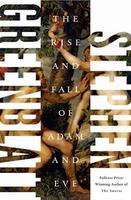 In his newest book, Stephen Greenblatt reaches back to "in the beginning" to learn more about who we are today.
In his newest book, Stephen Greenblatt reaches back to "in the beginning" to learn more about who we are today.
By Truelian Lee '21
As I sat down with Professor Stephen Greenblatt to talk about his new book The Rise and Fall of Adam and Eve, I soaked in the sight of the large bookshelves stuffed to the brim in his office. Our conversation was about the new book, but Greenblatt – and many other Harvard folks – will be at theBoston Book Festival on October 28 in Boston's Copley Square. The festival, incluing Greenblatt’s conversation with Harvard Law School's Martha Minow at 11:15 a.m., is free and open to the public. Excerpts from our conversation follow.
What is the impact of the myth of Adam and Eve on our daily lives?
A lot of beliefs are what people make of them, what kind of lives they live using those beliefs. And over the centuries, they've been used in lots of different ways. Basically, it's been for a very long time a way for people to organize themselves toward the fundamental facts of human existence in a variety of different ways. Love, desire, the need to labor for life, fear, snakes, sexual longing, mortality and so forth. What's remarkable is that these stories that are extremely small explain just about everything – pain,

What inspired you to explore this myth and its repercussions?
I've always loved and been fascinated by storytelling. So, the core inspiration or interest for me is was in how this tiny little story is just a page and a half in the Bible, and why this story has worked so powerfully over now thousands of years for Judaism and Islam. And I was thought this was a good way of focusing on how a truly great story works, how art works – basically how narrative storytelling works.
And did you feel like you reached an answer to those how narrative storytelling works?
I would have said the answer in an extremely brief form would lie in two different places. One is the fact that the story in a very pure form does work. I think what great art does is to demand that you understand it. You have to bring yourself entirely to the enterprise. And that was true of the figures that I wrote about.
When you decided that you would be researching more on the myth of Adam and Eve what was your research process like? How did you eventually gather all the material needed to write your book?
You sometimes think that you bring the research into the classroom afterwards, but it also happens the other way around. I began my thinking about this topic when I was teaching a course with Professor Joseph Koerner in the general education requirement. During the course of my research, I began to think about what do I have to say about this myth, and what do I want to say.
How were you able to reach a sense of closure on this project?
I personally wished a sense of closure on the project by going to western Uganda and observing chimpanzees in the wild. I wanted to see for myself what our own contemporary account of our origins looks like when it's at its most realistic. Which is not to say that we descended from chimpanzees, but rather that they are closer to our last common ancestor than any other living creature. So, for me that was a wonderful trip.
What is the key takeaway that you would help your students get from reading your book?
One doesn't want one's book to be reduced to the format of a few sentences. But if I had to, I would say that at least for me that you know the human imagination and particularly the imagination in the form of the storytelling imagination is ultimately on the side of human enlightenment and not only of piety. A story can live on long after maybe even the intentions of the people who created it.